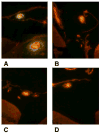The kinase inhibitory region of SOCS-1 is sufficient to inhibit T-helper 17 and other immune functions in experimental allergic encephalomyelitis
- PMID: 21131060
- PMCID: PMC3053067
- DOI: 10.1016/j.jneuroim.2010.10.018
The kinase inhibitory region of SOCS-1 is sufficient to inhibit T-helper 17 and other immune functions in experimental allergic encephalomyelitis
Abstract
Suppressors of cytokine signaling (SOCS) negatively regulate the immune response, primarily by interfering with the JAK/STAT pathway. We have developed a small peptide corresponding to the kinase inhibitory region (KIR) sequence of SOCS-1, SOCS1-KIR, which inhibits kinase activity by binding to the activation loop of tyrosine kinases such as JAK2 and TYK2. Treatment of SJL/J mice with SOCS1-KIR beginning 12 days post-immunization with myelin basic protein (MBP) resulted in minimal symptoms of EAE, while most control treated mice developed paraplegia. SOCS1-KIR treatment suppressed interleukin-17A (IL-17A) production by MBP-specific lymphocytes, as well as MBP-induced lymphocyte proliferation. When treated with IL-23, a key cytokine in the terminal differentiation of IL-17-producing cells, MBP-sensitized cells produced IL-17A and IFNγ; SOCS1-KIR was able to inhibit the production of these cytokines. SOCS1-KIR also blocked IL-23 and IL-17A activation of STAT3. There is a deficiency of SOCS-1 and SOCS-3 mRNA expression in CD4(+) T cells that infiltrate the CNS, reflecting a deficiency in regulation. Consistent with therapeutic efficacy, SOCS1-KIR reversed the cellular infiltration of the CNS that is associated with EAE. We have shown here that a SOCS-1 like effect can be obtained with a small functional region of the SOCS-1 protein that is easily produced.
Copyright © 2010 Elsevier B.V. All rights reserved.
Conflict of interest statement
The authors have no financial conflict of interest.
Figures










Similar articles
-
SOCS1 Mimetics and Antagonists: A Complementary Approach to Positive and Negative Regulation of Immune Function.Front Immunol. 2015 Apr 21;6:183. doi: 10.3389/fimmu.2015.00183. eCollection 2015. Front Immunol. 2015. PMID: 25954276 Free PMC article. Review.
-
Both the suppressor of cytokine signaling 1 (SOCS-1) kinase inhibitory region and SOCS-1 mimetic bind to JAK2 autophosphorylation site: implications for the development of a SOCS-1 antagonist.J Immunol. 2007 Apr 15;178(8):5058-68. doi: 10.4049/jimmunol.178.8.5058. J Immunol. 2007. PMID: 17404288
-
A cell penetrating peptide from SOCS-1 prevents ocular damage in experimental autoimmune uveitis.Exp Eye Res. 2018 Dec;177:12-22. doi: 10.1016/j.exer.2018.07.020. Epub 2018 Jul 23. Exp Eye Res. 2018. PMID: 30048621 Free PMC article.
-
Treatment of mice with the suppressor of cytokine signaling-1 mimetic peptide, tyrosine kinase inhibitor peptide, prevents development of the acute form of experimental allergic encephalomyelitis and induces stable remission in the chronic relapsing/remitting form.J Immunol. 2005 Oct 15;175(8):5077-86. doi: 10.4049/jimmunol.175.8.5077. J Immunol. 2005. PMID: 16210611
-
SOCS, Intrinsic Virulence Factors, and Treatment of COVID-19.Front Immunol. 2020 Oct 23;11:582102. doi: 10.3389/fimmu.2020.582102. eCollection 2020. Front Immunol. 2020. PMID: 33193390 Free PMC article. Review.
Cited by
-
Short peptide type I interferon mimetics: therapeutics for experimental allergic encephalomyelitis, melanoma, and viral infections.J Interferon Cytokine Res. 2014 Oct;34(10):802-9. doi: 10.1089/jir.2014.0041. Epub 2014 May 8. J Interferon Cytokine Res. 2014. PMID: 24811478 Free PMC article.
-
Regulation of Macrophage, Dendritic Cell, and Microglial Phenotype and Function by the SOCS Proteins.Front Immunol. 2015 Oct 27;6:549. doi: 10.3389/fimmu.2015.00549. eCollection 2015. Front Immunol. 2015. PMID: 26579124 Free PMC article. Review.
-
Corneal Application of R9-SOCS1-KIR Peptide Alleviates Endotoxin-Induced Uveitis.Transl Vis Sci Technol. 2021 Mar 1;10(3):25. doi: 10.1167/tvst.10.3.25. Transl Vis Sci Technol. 2021. PMID: 34003962 Free PMC article.
-
SOCS1 Mimetics and Antagonists: A Complementary Approach to Positive and Negative Regulation of Immune Function.Front Immunol. 2015 Apr 21;6:183. doi: 10.3389/fimmu.2015.00183. eCollection 2015. Front Immunol. 2015. PMID: 25954276 Free PMC article. Review.
-
SOCS1 and SOCS3 as key checkpoint molecules in the immune responses associated to skin inflammation and malignant transformation.Front Immunol. 2024 Jun 21;15:1393799. doi: 10.3389/fimmu.2024.1393799. eCollection 2024. Front Immunol. 2024. PMID: 38975347 Free PMC article. Review.
References
-
- Abbott NJ, Patabendige AAK, Dolman DEM, Yusof SR, Begey DJ. Structure and function of the blood-brain barrier. Neurobio Dis. 2010;37:13–25. - PubMed
-
- Alexander WS, Hilton DJ. The role of suppressors of cytokine signaling (SOCS) proteins in regulation of the immune response. Ann Rev Immunol. 2004;22:503–529. - PubMed
Publication types
MeSH terms
Substances
Grants and funding
LinkOut - more resources
Full Text Sources
Other Literature Sources
Research Materials
Miscellaneous

